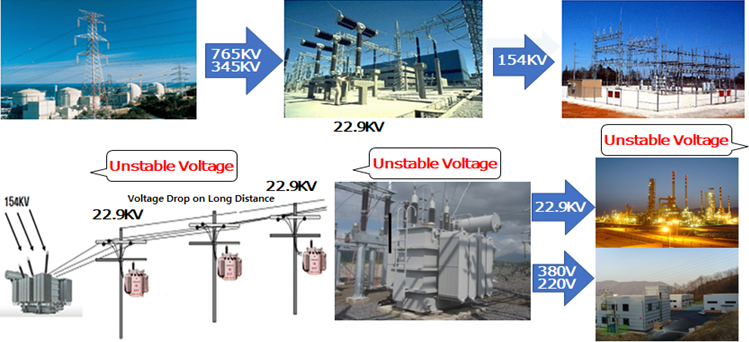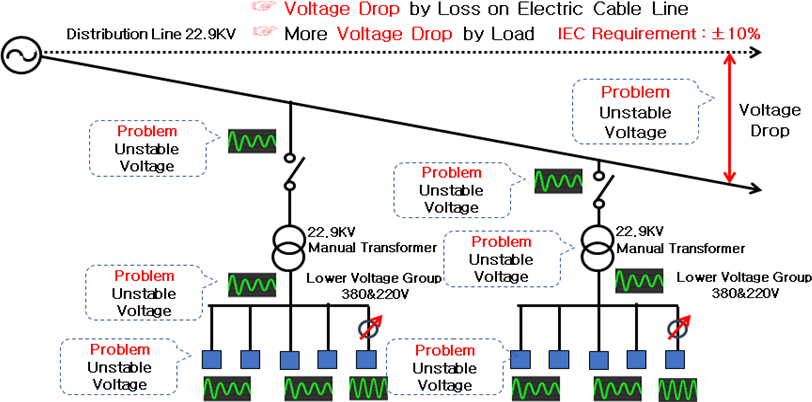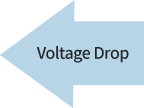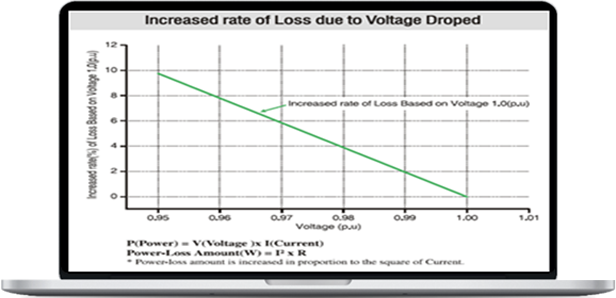Electric Power Transmission & Distribution Flow Diagram
When “Intelligent Transformer” which can adjust voltage in real time, is used to resolve unstable voltage problem,
voltage will be stabilized, efficiency will be improved, loss will be reduced, and electric cost wll be reduced.
Voltage Drop Problem
Traditional manual transformers cannot respond when unstable voltage is loaded to the transformers.
If unstable voltage were loaded onto the manual transformers, the output voltage is surely unstable as well, and all the
load is used under unstable state, and it causes worse efficiency and larger loss.
If Voltage is Unstable?
Problem
Voltage Drop
Blackout
Transformer Accident
Larger Electric Power Loss
Lower Load Efficiency
Higher Maintenace Cost
Hihger Electricity Price
Lower Light Output
Increase of Errors
Lower Performance of Load Equipments
Malfunctions of Motor-driven Devices
Lower Product Quality
Higher Defection Ratio
Lower Productivity
Problem
Overvoltage
Blackout
Transformer Accident
Larger Load Torque
Higher Output causing Waste of Electricity
Overheating of Load Equipments
Failures of Load Equipments
Shorten Life of Load Equipments
Higher Maintenance Cost
Higher Electricity Price
Increase of Errors
Malfunctions of Motor-driven Devices
Lower Product Quality
Higher Defection Ratio
If electric voltage is unstable, lower efficiency and higher loss occur in case of voltage drop.
On overvoltage situation, more serious problems can happen. It’s like a cycle of high blood pressure and low blood pressure in human body
or a cycle of high speed and low speed driving of a car. Therefore, maintaining “stably rated voltage” is most-preferred choice and
the stably rated voltage always produces minimum loss and maximum efficiency.
Electric Power Loss due to Voltage Drop
▶ Relationshiop of Voltage Drop and System Loss
P(Power) = V(Voltage)x I(Current) x Cos Ø(AC)
Voltage drop caused increased current Power Loss (W)
= I²(a square of Current) x R(Resistance) * Cos Ø(AC)
Power loss increment is proportional to a square of electric
current when resistance is identical.
-5% of voltage drop triggers -9.75% decrease of
electric power (on low-voltage line, loss is much larger and
voltage drop is much bigger)
When voltage drops 5%, loss is increased by 9.75%.
Voltage drop makes current to be increased, and loss is proportional to a square of the current.
Distributed Electric Power
Connecting points of distributed power (new renewable energy), might cause serious rising, fluctuating, and unstable voltage
problems with reversed power flow.
“Real-Time Voltage Controlling” Linear OLTC Intelligent Transformers can resolve the problems








